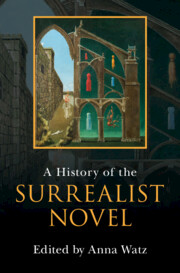Book contents
- A History of the Surrealist Novel
- A History of the Surrealist Novel
- Copyright page
- Dedication
- Contents
- Figures
- Contributors
- Acknowledgements
- Introduction
- I Marvellous Beginnings
- Chapter 1 Autobiography
- Chapter 2 Diverging Genealogies of the Surrealist Unconscious
- Chapter 3 Automatism, Autobiography, and Thanatography in the Surrealist Novel
- Chapter 4 Urban Nature: The City in the Surrealist Novel
- Chapter 5 Nostalgia and Childhood in the Surrealist Novel
- Chapter 6 Surrealist Collage Narrative
- II Transgression and Excess
- III Science, Alchemy, Nature
- IV Transnational Surrealism
- Index
Chapter 4 - Urban Nature: The City in the Surrealist Novel
from I - Marvellous Beginnings
Published online by Cambridge University Press: 02 February 2023
- A History of the Surrealist Novel
- A History of the Surrealist Novel
- Copyright page
- Dedication
- Contents
- Figures
- Contributors
- Acknowledgements
- Introduction
- I Marvellous Beginnings
- Chapter 1 Autobiography
- Chapter 2 Diverging Genealogies of the Surrealist Unconscious
- Chapter 3 Automatism, Autobiography, and Thanatography in the Surrealist Novel
- Chapter 4 Urban Nature: The City in the Surrealist Novel
- Chapter 5 Nostalgia and Childhood in the Surrealist Novel
- Chapter 6 Surrealist Collage Narrative
- II Transgression and Excess
- III Science, Alchemy, Nature
- IV Transnational Surrealism
- Index
Summary
Within a general modernist discourse of the phantasmagoria of the city, Le paysan de Paris stands out as a characteristic case of surrealist urban mythology. The book is seen as exemplary of the surrealists’ dedication to Paris, both as an urban reality and as a condition of possibility for their movement, in large part because of Walter Benjamin’s early focus on it. Benjamin’s reading of surrealism has largely oriented contemporary critical discourses, and one result of this is the invocation of an unbreakable association between surrealism and the city. However, in the middle of the ’movable feast’ that designated 1920s Paris as the Cosmopolis par excellence, it is to a ’peasant’, a non-urban figure, that Aragon gives Paris, and through whom Paris is given to us. This surrealist representation of the city breaks away from prevalent modernist accounts that pitch the ’city’ vs. ’country’ and ’urban’ vs. ’natural’. This chapter argues that the surrealist narratives which focus on the city undo prevalent tropes associated with the representation of the urban in modernity to ultimately subvert the genre of the novel as it was formed in the realist tradition.
- Type
- Chapter
- Information
- A History of the Surrealist Novel , pp. 72 - 86Publisher: Cambridge University PressPrint publication year: 2023

